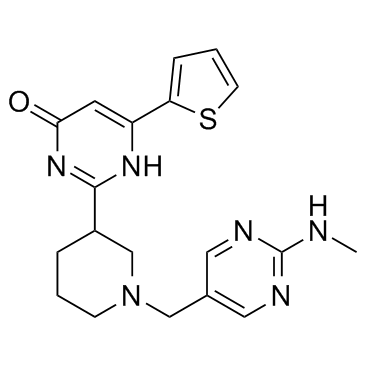Ribocil is a novel, potenty and highly selective chemical modulator of bacterial riboflavin riboswitches. Ribocil strongly inhibits GFP expression, achieving a 50% effective concentration (EC50) of 0.3 μM. Ribocil is a highly specific bioactive synthetic mimic of FMN, which competes with the natural ligand to inhibit FMN riboswitch-mediated expression of ribB and inhibits bacterial growth. Ribocil-B demonstrates superior microbiological activity as compared to Ribocil-A (minimum inhibitory concentration (MIC) = 1 μg/ml versus MIC ≥ 64 μg/ml), inhibition of riboflavin synthesis (IC50 = 0.13 μM versus IC50 > 26 μM), and binding affinity to the E. coli FMN aptamer (Kd = 6.6 nM versus Kd ≥ 10,000 nM). Riboswitches are non-coding RNA structures located in messenger RNAs that bind endogenous ligands, such as a specific metabolite or ion, to regulate gene expression. As such, riboswitches serve as a novel, yet largely unexploited, class of emerging drug targets. Demonstrating this potential, however, has proven difficult and is restricted to structurally similar antimetabolites and semi-synthetic analogues of their cognate ligand, thus greatly restricting the chemical space and selectivity sought for such inhibitors.
Physicochemical Properties
| Molecular Formula | C19H22N6OS |
| Molecular Weight | 382.482581615448 |
| Exact Mass | 382.157 |
| Elemental Analysis | C, 59.66; H, 5.80; N, 21.97; O, 4.18; S, 8.38 |
| CAS # | 1381289-58-2 |
| Related CAS # | Ribocil-C;1825355-56-3;Ribocil B;1825355-55-2;Ribocil-C Racemate;2309762-18-1 |
| PubChem CID | 136881500 |
| Appearance | Solid powder |
| Density | 1.3±0.1 g/cm3 |
| Boiling Point | 610.4±65.0 °C at 760 mmHg |
| Flash Point | 323.0±34.3 °C |
| Vapour Pressure | 0.0±1.8 mmHg at 25°C |
| Index of Refraction | 1.673 |
| LogP | 0.99 |
| Hydrogen Bond Donor Count | 2 |
| Hydrogen Bond Acceptor Count | 7 |
| Rotatable Bond Count | 5 |
| Heavy Atom Count | 27 |
| Complexity | 601 |
| Defined Atom Stereocenter Count | 0 |
| SMILES | S1C=CC=C1C1=CC(NC(C2CN(CC3=CN=C(NC)N=C3)CCC2)=N1)=O |
| InChi Key | ZSXCVAIJFUEGJR-UHFFFAOYSA-N |
| InChi Code | InChI=1S/C19H22N6OS/c1-20-19-21-9-13(10-22-19)11-25-6-2-4-14(12-25)18-23-15(8-17(26)24-18)16-5-3-7-27-16/h3,5,7-10,14H,2,4,6,11-12H2,1H3,(H,20,21,22)(H,23,24,26) |
| Chemical Name | 2-(1-((2-(methylamino)pyrimidin-5-yl)methyl)piperidin-3-yl)-6-(thiophen-2-yl)pyrimidin-4(3H)-one |
| Synonyms | Ribocil; |
| HS Tariff Code | 2934.99.03.00 |
| Storage |
Powder-20°C 3 years 4°C 2 years In solvent -80°C 6 months -20°C 1 month |
| Shipping Condition | Room temperature (This product is stable at ambient temperature for a few days during ordinary shipping and time spent in Customs) |
Biological Activity
| ln Vitro | Ribocil, a highly selective chemical modulator of bacterial riboflavin riboswitches, which was identified in a phenotypic screen and acts as a structurally distinct synthetic mimic of the natural ligand, flavin mononucleotide, to repress riboswitch-mediated ribB gene expression and inhibit bacterial cell growth. Our findings indicate that non-coding RNA structural elements may be more broadly targeted by synthetic small molecules than previously expected. |
| References |
[1]. Selective small-molecule inhibition of an RNA structural element. Nature. 2015 Oct 29;526(7575):672-7. |
Solubility Data
| Solubility (In Vitro) | DMSO : ~12.5 mg/mL (~32.68 mM) |
| Solubility (In Vivo) |
Solubility in Formulation 1: ≥ 1.25 mg/mL (3.27 mM) (saturation unknown) in 10% DMSO + 40% PEG300 + 5% Tween80 + 45% Saline (add these co-solvents sequentially from left to right, and one by one), clear solution. For example, if 1 mL of working solution is to be prepared, you can add 100 μL of 12.5 mg/mL clear DMSO stock solution to 400 μL PEG300 and mix evenly; then add 50 μL Tween-80 to the above solution and mix evenly; then add 450 μL normal saline to adjust the volume to 1 mL. Preparation of saline: Dissolve 0.9 g of sodium chloride in 100 mL ddH₂ O to obtain a clear solution. Solubility in Formulation 2: ≥ 1.25 mg/mL (3.27 mM) (saturation unknown) in 10% DMSO + 90% (20% SBE-β-CD in Saline) (add these co-solvents sequentially from left to right, and one by one), clear solution. For example, if 1 mL of working solution is to be prepared, you can add 100 μL of 12.5 mg/mL clear DMSO stock solution to 900 μL of 20% SBE-β-CD physiological saline solution and mix evenly. Preparation of 20% SBE-β-CD in Saline (4°C,1 week): Dissolve 2 g SBE-β-CD in 10 mL saline to obtain a clear solution. Solubility in Formulation 3: ≥ 1.25 mg/mL (3.27 mM) (saturation unknown) in 10% DMSO + 90% Corn Oil (add these co-solvents sequentially from left to right, and one by one), clear solution. For example, if 1 mL of working solution is to be prepared, you can add 100 μL of 12.5 mg/mL clear DMSO stock solution to 900 μL of corn oil and mix evenly. Solubility in Formulation 4: 10% DMSO+40% PEG300+5% Tween-80+45% Saline: ≥ 1.25 mg/mL (3.27 mM) (Please use freshly prepared in vivo formulations for optimal results.) |
| Preparing Stock Solutions | 1 mg | 5 mg | 10 mg | |
| 1 mM | 2.6145 mL | 13.0726 mL | 26.1452 mL | |
| 5 mM | 0.5229 mL | 2.6145 mL | 5.2290 mL | |
| 10 mM | 0.2615 mL | 1.3073 mL | 2.6145 mL |
